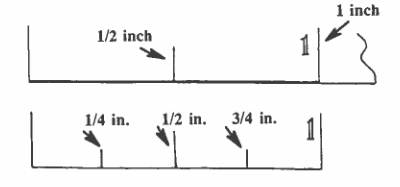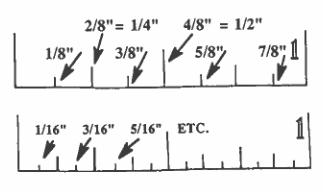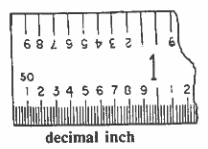Lesson 2: Fractional and Decimal Inches
Word List
Spelling Practice
Definitions
Word List
Spelling Practice
Vocabulary Practice
FRACTIONAL AND DECIMAL INCHES
The machinist must be very familiar with the inch, because it is the basic unit he/she will be using to measure the dimensions of parts. The machinist will also see the inch on blueprints and plans for parts she/he will be asked to make. The inch is a basic unit for measuring length within the United States Customary System of measurement. This system is still used everywhere in the trade, although many manufacturers in other countries are using the International Metric System.
The Metric System uses decimals to subdivide its units into smaller parts; the U.S. Customary System allows us to use either the fractional inch or the decimal inch. Let us look at each of these units.
1. The Fractional Inch: The fractional inch is an inch divided into smaller pieces which are fractional parts of the inch. Each time the inch is divided to make a smaller unit, the previous unit is divided in half. For example: The first division of the inch is into two pieces which are both 1/2 inch in length:
 The next division is to cut each of the halves into two equal pieces; this gives us four subdivisions of the inch into pieces which are each 1/4 inch in length.
The next division is to cut each of the halves into two equal pieces; this gives us four subdivisions of the inch into pieces which are each 1/4 inch in length.
This continual dividing of the previous unit into two equal pieces next produces eighths; then sixteenths, then thirty-seconds. and finally sixty-fourths. The subdividing stops at sixty-fourths, because that is about as fine a subdivision as we are able to see with our limited eyesight.
Look at the next page for examples of our “big inch” cut into eighths and into sixteenths.

You will notice that each time a part of the inch is cut in half again, the dividing line gets a little shorter. These fraction marks are not labeled, so it is necessary to know which marks show fourths, eighths, sixteenths, etc.
Reading a fractional inch measurement:
When you want to read a fraction mark:
- Decide what kind of fraction the mark is: a fourth, an eighth, a sixteenth, etc.
- Count the number of such marks you have, including the larger marks in between.
- If the mark is past the one-half mark, you may want to count backwards from the next whole inch.
Practice
ABBREVIATIONS
Abbreviations for the word inch are written as follows:
inch = in. or ” , e.g., 25 in., 1 in., or 35″, or 2″.
(There is no need to write an “s” to indicate plural inches; we write in. when we wish to indicate 25 in., or 1 in., or 3/4 in., or 1 3/4 in. We read these fractions “twenty-five inches”, “one inch”, “three quarters inch”, and “one and three quarters inches”.)
2. The Decimal Inch: It is more common to use the decimal inch in machine shop work than it is to use the fractional inch. An inch may be sub divided into tenths, hundredths, thousands and ten thousandths: Here are some examples of parts of an inch expressed as decimals:
a. 0.12 in. b. 34.023″ c. 0.5 in. d. 3.7835″
These fractions are read like this:
a. twelve hundredths inch
b. thirty-four and twenty-three thousandths inches
c. five tenths inch
d. three and seven-thousand eight-hundred and thirty-five ten-thousandths inches
A. Get the tape recorder and the tape marked “Mod 4, Less 2”; listen to the tape as you look at the decimals below.
| a. 23.7 in. | b. 4.007 in. | c. 0.235 in. | d. 25.0035 in. |
| e. 247.875 in. | f. 56.7 in. | g. 35.1765 in. | h. 2.012 in. |
| i. 53.75″ | j. 72.5″ | k. 0.0003″ | l. 225.037″ |
| m. 7.077″ | n. 48.05″ | o. 673.0089″ | m. 29.9″ |
Now press the “pause” button for a moment, until you read and understand what to do for the next exercise.
B. In a moment you wll be asked to turn on the tape again. You will first hear the letter of the decimal inch printed on the page. You will have a few seconds to read the decimal out loud, before the tape reads it for you. See if you can beat the tape and read the decimals correctly before it does.
Ready? Press down the “pause” button again and begin listening and speaking. Write the letters of any that you miss; then practice those separately.
| a. 35.007 in. | b. 784.5 in. | c. 12.0035 in. | d. 5.087 in. |
| e. 96.117 in. | f. 0.4567 in. | g. 3.09 in. | h. 23.089 in. |
| i. 0.17″ | j. 55.018″ | k. 872.35″ | l. 29.0545″ |
| m. 0.0009″ | n. 419.7″ | o. 61.895″ | p. 2384.69″ |
C. Now listen to the tape and write what you hear in the spaces below.Then check your answers on the next page.
a.
b.
c.
d.
e.
f.
Answers to part C from the previous page; circle the letters of any you missed, and practice them further.
a.56.5 in. d.412. 84 ” b.729.057 ” e.0.12 in. c.0.9715 “f. 47.825 in.
Reading a Decimal Inch measurement: Pictured to the right is a ruler which has the inch marked  off into decimal subdivisions: tenths of an inch on the top scale and fiftieths and tenths on the bottom scale. We know that the ruler is divided into fiftieth marks, because of the 50 stamped on the ruler; that means that the inch is divided into 50 equal pieces. In decimal expression, each mark, then, is equal to 0.02 in. (1/50 = 0.02); 0.01 would be equal to half of the distance between any two of those marks.
off into decimal subdivisions: tenths of an inch on the top scale and fiftieths and tenths on the bottom scale. We know that the ruler is divided into fiftieth marks, because of the 50 stamped on the ruler; that means that the inch is divided into 50 equal pieces. In decimal expression, each mark, then, is equal to 0.02 in. (1/50 = 0.02); 0.01 would be equal to half of the distance between any two of those marks.
It will be difficult to read the smaller decimal subdivisions of an inch from a ruler. In Module 5, we will be studying measuring instruments; many of them are designed to give us measurements which are as small as thousandths or ten thousandths of an inch. We will be able to read these very small lengths by looking at dials or scales on a variety of instruments.
Practice Reading a Decimal Inch Ruler

